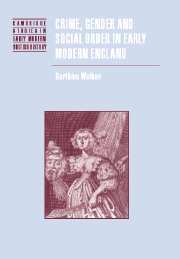Book contents
- Frontmatter
- Contents
- List of figures and tables
- Preface
- Note on quotations and dates
- List of abbreviations
- 1 Introduction
- 2 Men's non-lethal violence
- 3 Voices of feminine violence
- 4 Homicide, gender and justice
- 5 Theft and related offences
- 6 Authority, agency and law
- 7 Conclusion
- Bibliography
- Index
- Titles in the series
3 - Voices of feminine violence
Published online by Cambridge University Press: 14 July 2009
- Frontmatter
- Contents
- List of figures and tables
- Preface
- Note on quotations and dates
- List of abbreviations
- 1 Introduction
- 2 Men's non-lethal violence
- 3 Voices of feminine violence
- 4 Homicide, gender and justice
- 5 Theft and related offences
- 6 Authority, agency and law
- 7 Conclusion
- Bibliography
- Index
- Titles in the series
Summary
Existing historiography presents women as victims rather than perpetrators of violence. It is true that typically a minority of violent offenders, between ten and twenty per cent, were female. Yet privileging victimhood over agency is an interpretative matter. The low incidence of women's violence relative to men's has been considered a consequence of biology, of prescriptive social roles, of the internalisation (by either or both sexes) of patriarchal ideology. Whatever the case, the upshot is the same: female violence was typically perceived as ‘same-sex violence’, ‘rather trivial’ and inconsequential. Feminine violence that by conventional standards was ‘serious’ – when women killed, for instance – is sensationalised as an aberration from ‘normal’ gendered behaviour. ‘Unnaturally’ violent women are either (like infanticidal mothers) casualties of oppressive gender codes or (like those who impersonated male highway robbers) rejecters of them. This interpretative model of men's violence as ‘normal’ and women's as numerically and thus culturally insignificant is inadequate. I am not contesting the fact that women were a minority of those prosecuted for violent crimes. I am suggesting, however, that exploring women's violence in its own terms may prove more fruitful for the historian than simply dismissing it as an anomaly.
MODES OF WOMEN'S VIOLENCE
Household concerns
One well-rehearsed explanation for the low incidence of women as sole assailants cites women's ‘more dependent and passive’ nature, and their reliance upon men, especially their husbands, to settle their quarrels for them.
- Type
- Chapter
- Information
- Crime, Gender and Social Order in Early Modern England , pp. 75 - 112Publisher: Cambridge University PressPrint publication year: 2003

